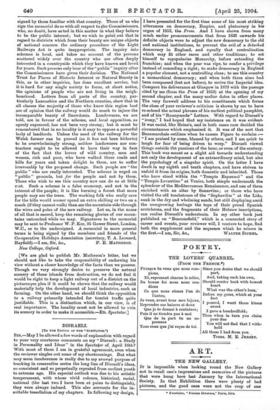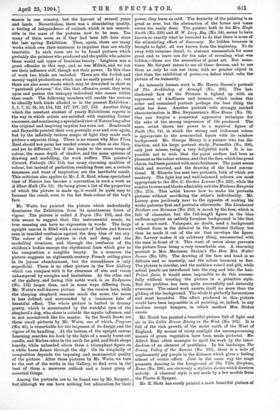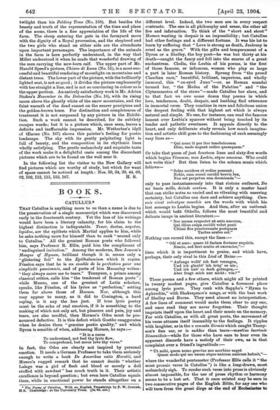season in one country, but the harvest of several years
and lands. Nevertheless, there was a stimulating quality, a feeling of independence of outlook, which is not remark- able in the mass of the pictures now to be seen. Too many of them seem as if they bad been left here since the last spring Exhibition. Then, again, there are many works which owe their existence to impulses that are wholly inartistic. In each room are to be found pictures which probably the painters who produced and the public who admire them would call types of feminine beauty. Leighton was a great offender in this way, and so was Millais, and we can see their influence still, though not their power. In this class of work two kinds are included. There are the foolish and merely vapid productions which can be easily passed by; but there are also some works which may be described in short as "patchouli pictures," for, like that offensive scent, they seize upon and pursue the unhappy individual who comes within their reach. The following numbers will enable the curious to identify both kinds alluded to in the present Exhibition : 1, 5, 7, 31, 35, 58, 114, 122 127, 197, 227, 252. Another thing which the constant student of yearly Exhibitions regrets is the way in which artists are satisfied with repeating former successes, and continuing a specialised view of Nature long after the original and inspiring impulse has worn out. Rembrandt and Reynolds painted their own portraits over and over again, but by the infinitely various magic of light they made each picture a separate thing. There is no reason why Miss Flora Reid should hot paint her market scenes as often as she likes, and yet be different; but if she keeps to the same range of colour, the same depth of shadow, and the same systems of drawing and modelling, the work suffers. This painter's Cornish Fishwife (No. 154) has many charming qualities of colour, but instead of perfection resulting from use, a certain tameness and want of inspiration are the inevitable result. This criticism also applies to Mr. J. R. Reid, whose specialised view of Nature .has become a convention in such a work as A Sheer Hulk (No.12). On being given a list of the properties of which the picture is made up, it would be quite easy to forecast the result, even to the hot flesh-colour of the boy's face.
Mr. Watts has painted the picture which undoubtedly dominates the Exhibition from its spontaneous burst of vigour. The picture is called A Fugue (No. 193), and the title seems to suggest that, like instrumental music, its true meaning can have no expression in words. The large upright canvas is filled with a cataract of babies and flowers seen in tumbled confusion against the deep blue of the sky. The colour of the picture is riots and deep, and the modelling vivacious, and through the confusion of the children's bodies emerge the rhythmical lines which give to the composition a songlike beauty. In a measure the picture suggests an eighteenth-century French ceiling-piece in its joyous abandonment, but the resemblance is only superficial. There is no other picture in the New Gallery which can compare with it for clearness of aim and vision unhampered by scruples and hesitations. At the other end of the gallery, and facing this noble work, is an Endymion (No. 132) larger than, and in some ways differing from, Mr. Watts's well-known picture. In the version here, while the sleeping shepherd remains much the same, the moon is less defined, and surrounded by a luminous halo of beautiful effect. The whole picture is bathed in dreamy poetry, which is accentuated by the watchful eyes of the shepherd's dog, who alone is outside the mystic influence, and ie not moonstruck like his master. In the South Recta are three small pictures by Mr. Watts, one of which, Progress (No. 45), is remarkable for the largeness of its design and the vigour of its handling. At the bottom of the upright canvas Learning searches his book by the light of a nearly burnt-out candle, and Riches rakes in the earth for gold, and Sloth sleeps heavily, while unheeded above them a triumphant figure on a white horse flames through the sky. On its simplicity of composition depends the imposing and monumental quality of the picture. After these pictures by Mr. Watts, we turn to the rest of the works in the Gallery, to find even in the beat of them a narrower outlook and a lesser grasp of essential things.
Among the portraits are to be found two by Mr. Sargent ; but although we can have nothing but admiration for their
An intensely human work is Mr. Harris Brown's portrait of The Archbishop of Armagh (No. 201). The hat- shadowed face of the Primate is lighted up with an expression of kindliness and humour, which makes this sober and restrained portrait perhaps the best thing the artist has done. Another portrait with strongly marked characterisation is Mrs. Swynnerton's Miss Evans (No. 78). One can forgive a somewhat aggressive technique for the sake of the strong impression of life produced. The same artist shows her power in a mystical figure of Faith (No. 74), in which the strong and iridescent colour is appropriate to the armourclad figure with its rainbow background. Mr. George Henry is a painter who has dis- tinction, and his large portrait study, Poinsettia (No. 206), only just misses being a very delightful work. It is im- possible not to wish that the paint surface had been as pleasant as the colour scheme, and that the face, which has great charm, had been painted with more freshness. The paint seems thick and worried, and the drawing of the hand conven- tional. M. Blanche has sent two portraits, both of which are masterly. The light key and well-balanced colours are most appropriate to the Mrs. C. Gordon Lennox (No. 221), while the sombre browns and blacks admirably suit the Madame Bangnies (No. 275). This artist knows how to make his portraits pictures without sacrificing the sitter's individuality. Mr. Lavery goes perilously near to the opposite of making his works patterns first and portraits afterwards. His Lieutenant Freiherr von Neiman. (No. 253) is saved by the face, which is full of character, but the full-length figure in the blue uniform against an entirely formless background is like that of a court-card. Velasquez, no doubt, used a background without form in the Admiral in the National Gallery, but then he made it out of the air that envelops the figure. Mr. Lavery makes it an arbitrary thing, unconnected with the man in front of it. This want of union alone prevents the picture from being a very remarkable one. A charming portrait is Mrs. Marianne Stokes's The Hon. Mrs. Walter Tames (No. 120). The drawing of the face and head is so delicate and so masterly, and the colour harmony so fine. The picture is circular, and the necklace raised and gilt, while actual pearls are introduced into the ring and into the hair. Primd facie, it would seem impossible to do this success- fully without treating the picture in a primitive style. But the problem has been quite successfully and naturally overcome. The raised work asserts itself no more than the gilding of the background. The whole is perfectly harmonious and most beautiful. The effect produced in this picture would have been impossible in oil painting, or, indeed, in any medium except tempera, in which method Mrs. Stokes excels.
Mr. North has painted a beautiful picture full of light and air in his Little Rivers Rising in the West (No. 162). It is full of the rich growth of the moist earth of the West of England. By means of misty sunlight the uncompromising masses of green vegetation have been made pictorial. Mr. Alfred East often manages to spoil his work by the intro- duction of an element of prettiness. In his landscape, The Sunny Valley of the Somme (No. 192), there is a note of unpleasantly gay purple in the distance which gives a feeling almost of scenic, effect. Just in the same way the stage peasants dancing in the foreground of The Villa Borghese, Rome (No. 196), are obviously a stylistic device which deceives nobody. A classical style is not made by a few models from the Piazza di Spagna.
Mr. E. Stott has rarely painted a more beautiful picture of twilight than his Folding Time (No. 158). But besides the beauty and truth of the representation of the time and place of the scene, there is a fine appreciation of the life of the farm. The sheep entering the gate in the farmyard move with the dignity of a Royal procession, and the shepherd and the two girls who stand on either side are the attendants upon important personages. The importance of the animals in the farm is here perfectly understood, in the way that Millet understood it when he made that wonderful drawing of the men carrying the new-born calf. The upper part of Mr. Harold Speed's picture, Chiaro di Luna (No. 51), is a most suc- cessful and beautiful rendering of moonlight on mountains and distant trees. The lower part of the picture, with the brilliantly lighted seat, is not so good ; it divides the picture unpleasantly with too straight a line, and is not so convincing in colour as is the upper portion. An entirely satisfactory work is Mr. Adrian Stokes's November in the Dolomites (No. 16), with its rising moon above the ghostly white of the snow mountains, and the faint warmth of the dead sunset on the nearer precipices and the golden-brown trees. For distinction and completeness of treatment it is not surpassed by any picture in the Exhibi- tion. Such a work cannot be described, for its subtlety escapes words; but it is a picture which, once seen, leaves a definite and ineffaceable impression. Mr. Wetherbee's idyll of (Enone (No. 167) shows this painter's feeling for poetic landscape. The sky with its gently palpitating light is full of beauty, and the composition in its rhythmic lines wholly satisfying. The gentle melancholy and exquisite taste of the work make it a delightful oasis among the discordant pictures which are to be found on the wall near it.
In the following list the visitor to the New Gallery will find pictures which are worthy of study, but which for want of space cannot be noticed at length Nos. 30, 34, 38, 44, 69, 92, 102, 112, 115, 153, 167. H. S.
BOOKS.
OATIILLUS.*
" Qui none it per iter tenebricosum Elm, wide negant redire quemquam."
Or take that poem of just fourteen lines and sixty-five words
which begins Vivamus, men Lea bin, ague amemus. Who could
not write this P But then listen to the solemn music which
follows-
" Soles occidere et redire pownint ; Nobis, cum semel oecidit brevis lux, Nox est perpetua una dormienda"—
only to pass instantaneously into that riotous outburst, Da mi basin mills, cleinde centum. It is only a master hand
that can strike notes so varied and so vibrating with unerring certainty, but Catalina can dare and achieve anything. Cam
suis vivat valeatque moechis are the words with which hie
last message to Lesbia begins. And then, after an outbreak which would befit Othello, follows the most beautiful and delicate image in ancient literature:-
" Nee. mean respectet nt ante amorem,
Qui illiva culpa cecidit velut prati Ultimi floe praeteretuate postguam
Nothing can exceed this, except the lines :— " Odi et amo : Beare id faciam fortasse requiris.












































 Previous page
Previous page